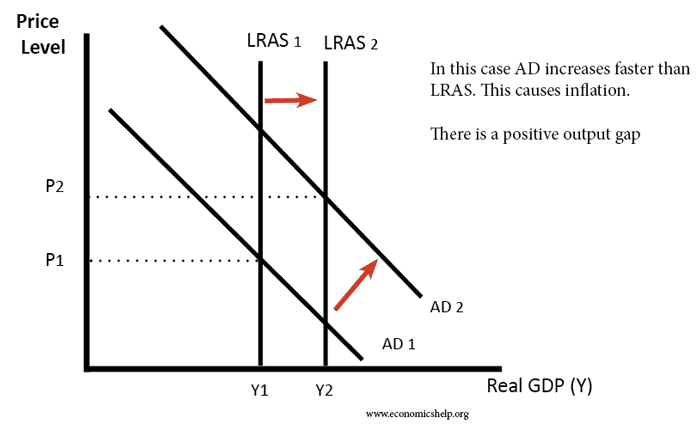Equilibrium national income occurs where aggregate supply equals aggregate demand.
An increase in equilibrium national income requires an increase in long-run aggregate supply and aggregate demand.
Equilibrium national income and Keynesian Consumption function

Policies to increase national income
Fiscal Policy
To increase AD, the government can pursue expansionary fiscal policy. This involves cutting taxes and increasing government spending. This injection into the circular flow will increase AD (AE) and cause Real GDP to increase.
However, expansionary fiscal policy has many limitations including:
- Time lags
- Crowding out effect.
- Other components of AD
- Higher Government borrowing
- For more details see: Evaluation of fiscal Policy
Monetary Policy
To increase AD, the government or monetary authorities can reduce interest rates to boost AD.
Lower interest rates reduce the cost of borrowing and therefore encourage firms to invest and consumers to increase spending. This leads to higher aggregate demand.
More on monetary policy
Exchange rate policy
In a semi-fixed exchange rate, the government could also devalue the exchange rate, making exports more competitive and imports more expensive. This will lead to greater domestic demand. This is not so common, but it can occur as a way to boost domestic demand. For example, the UK devaluation of 1992.
Supply-side policies
Another strategy to boost equilibrium national income is to focus on the supply side of the economy. Boosting productivity will increase aggregate supply and this productivity rise is also likely to have a knock-on effect in boosting domestic demand. Supply-side policies could include
- Privatisation
- Deregulation
- Lower taxes
- spending on education and training
Related


Can you give me an exaple how to write the intoroduction of this essay…thank u
Yes that would be great,if you could give an idea about the introduction.Thank you very much
Can I have more elaaboration on the exchange rate? thanks
can anyone help me !!!
1. The diagram depicts the current position of a hypothetical economy using the Keynesian Income/Expenditure approach. If national income is currently at Y1 explain why this cannot be an equilibrium position for the macroeconomy.
2.From the starting position of national income at Y1 explain the process by which the economy will move towards its equilibrium position.
3.As the economy adjusts towards this equilibrium what would you expect to be happening to inflation and unemployment? Explain your reasoning.
4.For this hypothetical economy the current equilibrium level of output/income is £200 billion made up of Consumption £150 billion, savings £15 billion, taxation £15 billion and imports £20 billion. If the government decides to increase its expenditure by £20 billion what will be the new equlibrium level of output/income. Explain your reasoning as well as the process that will lead the economy towards this new equilibrium.